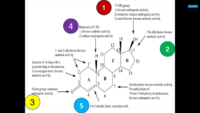This will be an ongoing inquisition as to the effects of the variety of attachments which are a part of or can be made to a steroid molecule. Particularly the commonly known ones.
Any input is welcome. Cited sources are best.
Anyone with a degree in the subject, feel free to offer up a long winded dissertation.
I will post information I have found thus far and my suppositions as they come.
Any input is welcome. Cited sources are best.
Anyone with a degree in the subject, feel free to offer up a long winded dissertation.
I will post information I have found thus far and my suppositions as they come.

